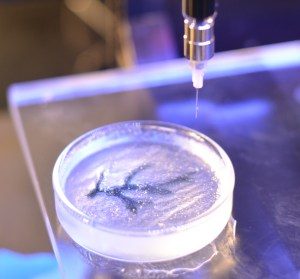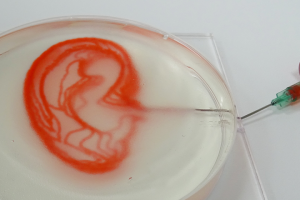Most biomaterials all are vastly different than each other in interesting ways. For those who have kept up with this series, it is safe to assume we still have a bunch of materials to analyze and understand. The field of biomaterials is vast and we need to understand all our options for bioprinting. Most additive manufacturing industries are comparatively simple and have polymer standards when it comes to 3D printing. So the materials are often derivatives and are similar to existing well-understood materials. This is not the case yet in bioprinting because of how complex biology is. We cannot limit the scope of materials because different materials are beneficial for a wide array of purposes within bioprinting. Today we will take a look into how gelatin is used in bioprinting.
Gelatin is a translucent, colorless, brittle (when dry), substance that is derived from collagen obtained from various animal body parts. It is also referred to as hydrolyzed collagen, collagen hydrolysate, gelatine hydrolysate, hydrolyzed gelatine, and collagen peptides. It is typically used as a gelling agent in food, medications, photographic films, and cosmetics.
Gelatin formation through collagen hydrolysis
It is important to understand the terminology of a hydrolyzed collagen within bioprinting. Collagen is the most abundant protein in the body and helps give structure to our hair, skin, nails, bones, ligaments, and tendons in our body. Collagen allows us to move, bend and stretch. Collagen also keeps our hair shiny, our skin glowing, and our nails strong. It is an essential protein.
Collagen cannot be absorbed by the body unless it is hydrolyzed. This means that the process of hydrolysis must occur before it can be effectively absorbed. Water is used to break down a collagen into its components. These components are amino-acids such as glycine, proline, hydroxyproline, and arginine, all of which help our body’s connective tissue, skin, hair, nails, as well as gut health.
Earlobe Vasculator Structure from Gelatin
With all that info stuffed down your throats, I am sure you are wondering how is this relevant for bioprinting. Typically gelatins are used to create hydrogels. We have discussed hydrogels in general before in this series. These particular gelatin hydrogels have important properties. They have excellent biocompatibility due to the amount of amino-acid components embedded within them. They have rapid degradability due to how they break down in reaction to water. They lastly have non immunogenicity due to how readily available the components of a gelatin are within the human body.
The biggest pain point for gelatin hydrogels is the melting point temperature. Gelatins are thermosensitive polymers. This causes tensile strength to sharply reduce once the material is above 28 degrees Celsius. The strength of a gelatin is also dependent on other additives that are used in combination with it.
This is only us scratching the surface on gelatin as a biomaterial. Through this series we hope that people realize that we are only giving small pieces of info out. We encourage you as a reader to follow up and learn more from reading and expanding your knowledge. Maybe an interest for bioprinting will lead to you studying more biochemistry and a variety of topics. We will continue to give you small sample sizes of the vast world within biology and how it can be applied to bioprinting. Leave some comments even on some things you would like to know about as a reader.
Subscribe to Our Email Newsletter
Stay up-to-date on all the latest news from the 3D printing industry and receive information and offers from third party vendors.
Print Services
Upload your 3D Models and get them printed quickly and efficiently.
You May Also Like
Making Space: Stratasys Global Director of Aerospace & Defense Conrad Smith Discusses the Space Supply Chain Council
Of all the many verticals that have been significant additive manufacturing (AM) adopters, few have been more deeply influenced by the incorporation of AM into their workflows than the space...
EOS in India: AM’s Rising Star
EOS is doubling down on India. With a growing base of aerospace startups, new government policies, and a massive engineering workforce, India is quickly becoming one of the most important...
PostProcess CEO on Why the “Dirty Little Secret” of 3D Printing Can’t Be Ignored Anymore
If you’ve ever peeked behind the scenes of a 3D printing lab, you might have caught a glimpse of the post-processing room; maybe it’s messy, maybe hidden behind a mysterious...
Stratasys & Automation Intelligence Open North American Tooling Center in Flint
Stratasys has opened the North American Stratasys Tooling Center (NASTC) in Flint, Michigan, together with automation integrator and software firm Automation Intelligence. Stratasys wants the new center to help reduce...





































